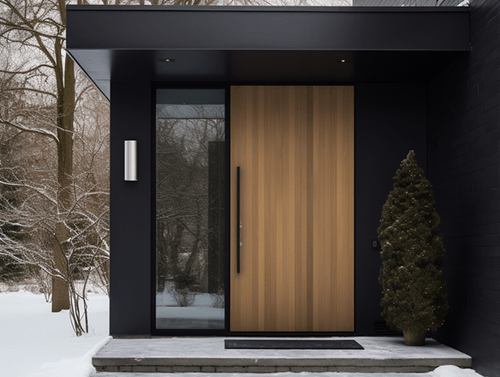Wooden doors have been a popular choice for centuries due to their durability, beauty, and versatility. However, did you know that there are also significant environmental benefits of using wooden doors? In this article, we’ll explore how wooden doors can help reduce your carbon footprint and contribute to a more sustainable future.
Wood is a Renewable Resource

One of the key environmental benefits of wooden doors is that wood is a renewable resource. Wood is one of the most abundant and versatile natural resources on the planet, and it is also a renewable resource.
Unlike non-renewable resources such as oil, coal, or gas, which are finite and can only be used once, wood is a resource that can be regrown and replenished.Trees are the source of wood, and they play a vital role in our ecosystem. Trees absorb carbon dioxide from the atmosphere and release oxygen through photosynthesis.
This process helps to regulate the Earth’s climate and provides us with the oxygen we need to breathe. Wood is harvested from trees that are grown in managed forests, where trees are replanted after they are harvested. This means that the forests can continue to provide a sustainable supply of wood for generations to come.
In fact, according to the USDA Forest Service, the net volume of trees in U.S. forests has been increasing for the past 60 years, meaning that we are growing more trees than we are harvesting.Forestry practices have improved significantly over the years, and many manufacturers today use sustainable forestry practices to ensure that their wood is sourced from responsibly managed forests.
These practices include planting more trees than are harvested, protecting wildlife habitats, and ensuring that the forest ecosystem is maintained.
Wood is Biodegradable

Another key environmental benefits of wooden doors is that wood is a biodegradable material. Biodegradability refers to a material’s ability to decompose naturally in the environment, returning to its organic form without leaving behind any toxic residues or harmful byproducts.
This makes wood a highly sustainable choice for building materials and products, especially when compared to non-biodegradable materials like plastic or metal.
Wood is biodegradable because it is composed primarily of organic matter, including cellulose, lignin, and other natural compounds. These organic materials are easily broken down by microorganisms and other natural processes in the environment.
As a result, wood products can be disposed of safely and sustainably, either by returning them to the natural environment or by recycling them into new wood products.
Wood is Energy-Efficient

Another important environmental benefit of wooden doors is that wood is an energy-efficient material. Wood is a natural insulator, which means that it can help regulate temperature and humidity levels in buildings, reducing the need for energy-intensive heating and cooling systems.
This can have a significant impact on reducing energy consumption and associated carbon emissions.When used as a building material, wood has a much lower embodied energy than other materials like concrete, steel, or plastic.
Embodied energy refers to the total energy required to extract, process, transport, and manufacture a material or product. Wood requires significantly less embodied energy than other building materials, making it a more environmentally friendly option.
Moreover, wood has a high thermal mass, which means that it can absorb and store heat. This can help regulate temperature and reduce the need for energy-intensive heating and cooling systems in buildings. Additionally, wood products have a lower thermal conductivity than other materials like steel or concrete, which means that they can help reduce energy transfer between different areas of a building.
Wood is Recyclable

While wooden doors are biodegradable, they can also be recycled. When a wooden door reaches the end of its useful life, it can be broken down and used to create new products such as paper, mulch, or even new wooden doors. This reduces the amount of waste sent to landfills and helps conserve natural resources.Wood can be recycled in several ways.
One common method is mechanical recycling, which involves grinding or shredding wood products into small pieces that can be used to create new wood-based materials. For example, recycled wood can be used to manufacture particleboard, oriented strand board (OSB), and other composite wood products.
Another method of recycling wood is chemical recycling, which involves breaking down wood products into their component parts using heat or chemicals. The resulting products can then be used to create new materials or fuels. For example, wood can be converted into biochar, a type of charcoal that can be used to improve soil quality and sequester carbon.
In addition to recycling, wood can also be reused or repurposed. Wooden doors, for example, can be salvaged and refurbished for use in new buildings, or they can be turned into furniture or other decorative items. This extends the life of the wood product and reduces the amount of waste generated.
Wood is Carbon-Neutral

Perhaps the most significant environmental benefit of wooden doors is that wood is a carbon-neutral material. When trees are growing, they absorb carbon dioxide from the atmosphere through a process called photosynthesis.
This carbon is then stored in the wood itself. When the wood is used to create products such as wooden doors, the carbon is locked away for the lifetime of the product. This means that wooden doors can actually help reduce the amount of carbon in the atmosphere, which is a major contributor to climate change.
Using wood as a building material can also help to reduce carbon emissions in other ways. For example, wooden doors and other wood-based products can help to improve the energy efficiency of buildings, reducing the need for energy-intensive heating and cooling systems. This, in turn, can lead to a reduction in carbon emissions associated with energy use.
Wood is a Sustainable Choice

Finally, using wooden doors is a sustainable choice. Unlike synthetic materials, wood is a natural and renewable resource that can be grown and harvested in a way that is environmentally responsible. Many manufacturers today use sustainable forestry practices to ensure that their wood is sourced from responsibly managed forests. By choosing wooden doors, you are supporting these sustainable practices and contributing to a more sustainable future.
Conclusion
Wooden doors as an exterior doors offer many environmental benefits that make them an excellent choice for your home or building. From being a renewable resource to being carbon-neutral, using wooden doors can help reduce your carbon footprint and contribute to a more sustainable future. So, if you’re looking for a beautiful, durable, and eco-friendly door, consider choosing a wooden door for your next project.






